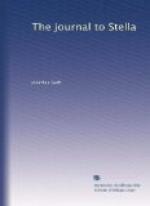6. No. 193 of the Tatler, for July 4, 1710, contained a letter from Downes the Prompter—not by Steele himself—in ridicule of Harley and his proposed Ministry.
7. Charles Robartes, second Earl of Radnor, who died in 1723. In the Journal for Dec. 3O, 1711, Swift calls him “a scoundrel.”
8. Benjamin Tooke, Swift’s bookseller or publisher, lived at the Middle Temple Gate. Dunton wrote of him, “He is truly honest, a man of refined sense, and is unblemished in his reputation.” Tooke died in 1723.
9. Swift’s servant, of whose misdeeds he makes frequent complaints in the Journal.
10. Deputy Vice-Treasurer of Ireland. In one place Swift calls him Captain Pratt; and in all probability he is the John Pratt who, as we learn from Dalton’s English Army Lists, was appointed captain in General Erle’s regiment of foot in 1699, and was out of the regiment by 17O6. In 17O2 he obtained the Queen’s leave to be absent from the regiment when it was sent to the West Indies. Pratt seems to have been introduced to Swift by Addison.
11. Charles Ford, of Wood Park, near Dublin, was a great lover of the opera and a friend of the Tory wits. He was appointed Gazetteer in 1712. Gay calls him “joyous Ford,” and he was given to over-indulgence in conviviality. See Swift’s poem on Stella at Wood Park.
12. Lord Somers, to whom Swift had dedicated The Tale of a Tub, with high praise of his public and private virtues. In later years Swift said that Somers “possessed all excellent qualifications except virtue.”
13. At the foundation school of the Ormonds at Kilkenny. (see note 22.)
14. A Whig haberdasher.
15. Benjamin Hoadley, the Whig divine, had been engaged in controversy with Sacheverell, Blackall, and Atterbury. After the accession of George I. he became Bishop of Bangor, Hereford, Salisbury, and Winchester in success.
16. Dr. Henry Sacheverell, whose impeachment and trial had led to the fall of the Whig Government.
17. Sir Berkeley Lucy, Bart., F.R.S., married Katherine, daughter of Charles Cotton, of Beresford, Staffordshire, Isaac Walton’s friend. Lady Lucy died in 174O, leaving an only surviving daughter, Mary, who married the youngest son of the Earl of Northampton, and had two sons, who became successively seventh and eighth Earls of Northampton. Forster and others assumed that “Lady Lucy” was a Lady Lucy Stanhope, though they were not able to identify her. It was reserved for Mr. Ryland to clear up this difficulty. As he points out, Lady Lucy’s elder sister, Olive, married George Stanhope, Dean of Canterbury, and left a daughter Mary,—Swift’s “Moll Stanhope,”—a beauty and a madcap, who married, in 1712, William Burnet, son of Bishop Burnet, and died in 1714. Mary, another sister of Lady Lucy’s, married Augustine Armstrong, of Great Ormond Street, and is the Mrs. Armstrong mentioned by Swift on Feb. 3, 1711, as a pretender to wit, without taste. Sir Berkeley Lucy’s mother was a daughter of the first Earl of Berkeley, and it was probably through the Berkeleys that Swift came to know the Lucys.




